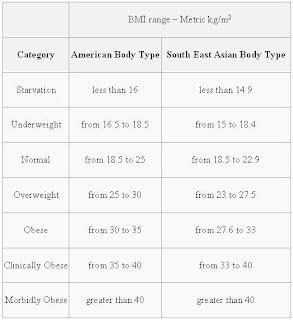It is one of of the most widely used and easiest way to find an individual's ideal body weight.
By calculating your own BMI and using the predefined values or range from the chart given one can find out if he Normal, Over-weight or Under-weight.
The further your BMI deviates from the normal range, the higher your risk for obesity-related health problems (such as diabetes, high blood pressure, high cholesterol, stroke, heart disease, and bone/joint disorders).
How To Find Your BMI
Body mass index is defined as the individual's body weight divided by the square of their height.
BMI may be accurately calculated using any of the formulas below.
 Once you find out what your BMI is, all u have to do is look up in the table for the range you fit in .
Once you find out what your BMI is, all u have to do is look up in the table for the range you fit in . Limitations
LimitationsThe flip side of BMI method and its simplicity is that it also has some limitations or flaws.
- Because the BMI is dependent only upon net weight and height, it assumes about distribution of muscle and bone mass.
- Thus it may overestimate adipose tissue or Fat on those with more lean body mass, like athletes or Body builders and may place them under Overweight range.
- Or it may underestimate adipose tissue or Fat on those with less lean body mass, like the elderly or individuals with low bone density under the Underweight range.
- With the variations of different body-types over the world, the range of Over-Underweight may change accordingly.
- Thus the Range may vary from time to time and country to country.
The Final word is, Apart from all these limitations and shortcomings BMI do gives a general and fair idea about an individual's Ideal body weight ( if he/she is Under Or Over weight). All of its strength lies in its simplicity and quick deduction.

No comments:
Post a Comment